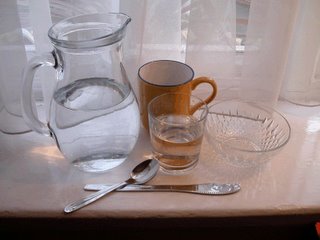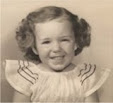Right: Still Life From Woolworth's

I heard the industrious sounds of someone sawing boards upstairs yesterday as early as 1 pm – a case of work ethic taking second place to tea ethic, I think – but who could blame Jill’s contractor for finding something better to do on the most beautiful day of the year to date? Not I, especially as the weather has gone back to being quite English today. Still, boards
did get sawed – a few, anyway. My room is that much closer to being ready for me, and my laundry got done at the launderette down the road, at the shocking (to me) rate of £3.60 for one small load washed and not quite dried.
Just up the road in Elephant and Castle is a low-rent, down-home shopping centre whose anchor stores are a Woolworth and a Price Busters. In the last few days I’ve combed through both these emporia for all those things one can’t do without, like tea mugs, tea spoons, and a kettle. Where I come from a tea kettle is a closed stainless steel pot under which one puts heat, and which whistles when the water is boiling (Note to any editors out there: in U.S. English we distinguish between restrictive and nonrestrictive pronouns, and know better than to use ‘which’ when we mean ‘that,’ and know to precede ‘which’ with a comma. I think this rule may never have existed in British English, or if it ever did it has become subservient to a sort of grammatical ethos that says “We do it this way. Live with it.”). Electric kettles exist in the colonies, but hardly anyone owns one. Here in the land that has taken tea to its heart, everyone owns one, and it’s usually made of plastic. I think the upper classes probably have flash stainless steel ones, but the rest of us get by with good old white plastic, like our foremums for centuries past. They don’t whistle, but they do shut off when the water reaches the proper temperature. I’ve had mine two days and it’s already collecting scale on the heating element from London water. At least I’m getting my minerals.
The name “Elephant and Castle,” I am told, is a creative interpretation of “Enfanta de Castile,” dating back to when that person visited London some centuries back. Leave it to the English to make something sensible (sort of) out of incomprehensible foreign syllables. A large and colorful statue of an elephant carrying a castle (rook) on its back like a howdah stands just outside the abovementioned shopping centre (itself just outside the E&C tube station) where everything from African dresses and headwraps to duvets and bedsheets can be found inexpensively, if not always in the size or color you need.
For color, it’s hard to beat London. The U.S. of the 21st century is certainly more diverse than the one I grew up in, but most of the places I’ve lived were pretty much white as mayonnaise by comparison to places I’ve been to over here since my first memorable visit back in ’95. Of course in the neighborhood I just left, Seattle’s Beacon Hill, it’s not uncommon to be the only caucasian on the bus as you ride from Beacon Avenue to the International District, and business signs are often in Chinese, Korean, Ethiopian, or Arabic first, and English second if at all. Still, London makes Beacon Hill look homogenized. Even in touristy areas the locals display a dazzling range of colors and speak a wonderful variety of languages. Here in Kennington, only one tube stop south of Waterloo Station, you can see beauty salons that advertise “European stylist available,” and get your email at the local Zimbabwean travel agency where English isn’t even a second language. Yesterday at the launderette I met a nicely-dressed man with ritual scars on his cheeks, and yet the stereotypical white Britons of the working and middle classes are everywhere to be seen, along with Brits whose parents hailed from you-name-it and beyond. I think it’s a carryover from Empire, about which more later.



0 comments:
Post a Comment